Matador Network's Blog, page 1220
November 16, 2018
Japan program gives away homes

If you’re a prospective homebuyer who is struggling to gather up the money for a downpayment or to be approved for a mortgage, you may want to consider moving to Japan. To keep good homes from going to waste, Japan is starting a program to reduce the number of abandoned homes across the country by offering them up for free, or selling them for next to nothing. Perhaps surprisingly, there are tons of abandoned and empty houses on the outskirts of Japan’s major cities — eight million of them according to a 2013 government report.
Japan’s aging population is partly responsible for the high number of abandoned houses in the country. There are few young people to purchase the homes of those who left them for retirement homes or who passed away. And the young people who are present take longer to have families for which they would need a home. To top it off, Japanese superstition makes selling old homes difficult as well. Properties associated with suicide, murder, or “lonely deaths” are considered bad luck, and there’s even a site called Oshimaland listing properties to be avoided.
Many homeowners are simply left with no choice but to give the houses away for free, with some local governments offering subsidies to encourage potential new owners to renovate the properties. Akiya banks are databases of abandoned homes for sale, which are generally organized by region. Most of the listed homes are either free, or being sold for peanuts. So if you want to get yourself cheap digs in Japan, the time is ripe. 
H/T: Culture Trip

More like this: 5 things tourists do in Japan that drive the locals crazy
The post Japan is giving away abandoned houses appeared first on Matador Network.

Cats want to break into Japan museum

Some people get dragged into museums against their will and can’t wait to get out. For two years, these two cats have been desperately trying to get in. Gosaku and Ken-chan, two cats living in the city of Onomichi in Japan, have been trying their best to break into the Onomichi Museum of Art. It all started back in 2016 when the museum hosted an exhibition of cat photography by Mitsuaki Iwago, and the two cats have been lurking around the grounds ever since, trying their best to get inside.
『甘えてる⁈ spoiled cat 』(H301109)スタッフ撮影の美術館周辺の猫スナップをご紹介。(spin off 2018、不定期配信) #尾道 #千光寺公園 #尾道市立美術館 #猫 #黒猫 #cat #onomichi pic.twitter.com/qDyt0n9vkQ
— 尾道市立美術館 (@bijutsu1) November 11, 2018
Rather than chasing the cats away, however, the museum’s guards take a more tender approach. Since they’re such regulars on the premises, the cats are treated to head pats, ear scratches, and ultimately, a gentle shooing away.
『珍客 a rare guest visitor 』(H301026)スタッフ撮影の美術館周辺の猫スナップをご紹介。(spin off 2018、不定期配信) #尾道 #千光寺公園 #尾道市立美術館 #猫 #茶トラ #cat #onomichi pic.twitter.com/EXIpjIesIp
— 尾道市立美術館 (@bijutsu1) October 27, 2018
『別角度 from another angle 』(H301031)スタッフ撮影の美術館周辺の猫スナップをご紹介。(spin off 2018、不定期配信) #尾道 #千光寺公園 #尾道市立美術館 #猫 #茶トラ #cat #onomichi pic.twitter.com/gFpLlVENrS
— 尾道市立美術館 (@bijutsu1) November 2, 2018
The museum itself has actually incorporated the cats into its gift shop souvenirs, and the museum’s official Twitter account regularly chronicles the felines’ movements. 
the museum made the black cat into a tote bag in their gift shop lol pic.twitter.com/Vmtej83Zlg
— main line mom (@snickidoodlee) November 14, 2018
H/T: Insider

More like this: These traveling Insta-cats prove cats are the purr-fect travel companions
The post Two cats have been trying to break into this Japanese museum since 2016 appeared first on Matador Network.

Remote workers initiative in Tulsa

Oklahoma has never seemed so exciting. As part of a new initiative, the city of Tulsa is offering $10,000 in grants and other benefits to those who move there and work remotely for a year. Tulsa Remote, funded by The George Kaiser Family Foundation, encourages those with full-time remote employment, or who are self-employed, to relocate to Tulsa to develop their business. Each $10,000 grant will be administered over the course of the year, with $2,500 for relocation expenses, followed by $500 monthly stipends, and a final $1,500 at the end of the 12-month period.
Successful applicants will be able to live in brand new, furnished apartments in the Tulsa Arts District for a 33 percent discount with free utilities for the first three months. They will also be provided with a workspace at 36 Degrees North.
Ken Levit, Executive Director of GKFF, went as far as to tell Tulsa World that Tulsa’s future depends on this initiative. “We are in an exciting spot,” he said. “Our Arts District is flourishing. Developments like the Gathering Place and Mother Road Market are enticing. This is a way to give an extra incentive to bring in talented people.” Levit’s hope is that people will enjoy their year so much, they’ll decide to stay permanently. He says they want remote workers to be “the kind of folks who are really going to be committed to give that year everything they have and really have a sense that they’re giving Tulsa a good-faith try for a lot longer period of time.”
To be eligible for this program, participants must provide proof of employment, be 18 years old or more, and work for a business that is based outside of Tulsa County or be self-employed outside of Tulsa County. Applicants will undergo an online interview with a potential in-person interview, as well. The first group of remote workers will arrive this coming spring, and applications can be filled out here. 
H/T: Tulsa World

More like this: These 7 US cities are over. Here’s where to go instead.
The post Tulsa will pay you $10,000 to move there for a year appeared first on Matador Network.

The perfect weekend in South Padre

For most of us, summer is long gone — barbecues, fresh seafood, and surfing are all things of the 2018 past. The scarves and boots are being rotated in…unless your travel plans include South Padre Island. It’s downright tropical here, with temperatures still hitting 70°F around December.
The water is warm, and it’s everywhere; South Padre Island is surrounded by the Gulf of Mexico and the Laguna Madre Bay. The Island isn’t even half a mile wide, so amazing views and delicious seafood are never more than a seaside stroll away. But even with a compact destination like this, you need to know how to navigate it — and here’s how.
THE ARRIVAL

Photo: South Padre Island
Let’s start by setting up your home base. South Padre has all your tried-and-true hotel options, but you’re not on a tried-and-true vacation. Here’s a brief rundown of some alternatives:
The resorts – Named one of the best resorts in Texas, Isla Grand Beach Resort is definitely a place to see and be seen. Its cabana rooms and condos come with views of tropical foliage, pools, and — of course — the beach.
The vacation rentals and homes – Vacation rentals offer the best of both worlds: island living with all the comforts of home. That’s true whether you’re looking for a modest space for two or plenty of room for a large group. Stay waterfront, just a few blocks from the shoreline, or among all the action in the heart of town. Choose a high-rise condo setting for unbeatable sunset views, or pick a beach-style bungalow for quiet mornings on the front porch. This way, your stretch of sand will totally feel like your own.
The adult-only facilities – Places like the Upper Deck Hotel & Bar are 18-only, gay-friendly, and have built-in nightlife that’s the good kind of loud. (Note: There are other venues around town that become 18+ or 21+ after a certain hour.)
With your lodging figured out, it’s time get out and into the wild. It’s your first night, so inaugurate your South Padre vacation by experiencing the bold, tropical flavors of the Island at one of its 40+ local dining and live music spots. If you dare, the buffet at Louie’s Backyard means a table full of endless crab legs, scallops, ribs, and shrimp. It’s got the “all-you-can-handle” vibes of Las Vegas, but way fresher, and way more local. Not to mention the west-facing location, just steps from the waters of the bay, makes this local favorite a hard-to-beat-spot for taking in your first SPI sunset.
For après-dinner, here are three solid options:
Dancing – Head to the Quarterdeck Lounge, located in the Isla Grand Beach Resort, to burn off those cals. Awesome bands from across the country play here on the regular.
Drinks – A couple spots you should check out are Coconuts Bar & Grill for the cocktails (frozen and otherwise) and Padre Island Brewing Company (it’s the second-oldest brewpub in the state!).
The beach by moonlight – If you can manage the walk to the other side of the Island after all those crab legs (relax, it’ll only take you 10 minutes), the beach is right there. Being on the sand come nightfall is its own kind of buzz.
DAY ONE
Morning + Afternoon
Any day you spend on South Padre Island is going to be a long, sunny one, which is its own kind of wonderfully tiring. Your necessary fuel can be found at the Grapevine Cafe & Coffeehouse in freshly brewed cups and on plates covered with pancakes, pecans, and fresh berries. Or cinnamon rolls, French toast, crab omelets, (corn!) biscuits and gravy, or humongous servings of chorizo con huevos. The breakfast selection is so good here, partly because it’s so diverse — they do equal parts Mexican, American, and espresso bar…a triple threat.

Photo: South Padre Island
In terms of how awesome waterparks can get, Schlitterbahn Beach Resort & Waterpark plays on a Michael Phelps level. Many a Texas kiddo is introduced to South Padre Island not as the site of Texas’s best beaches (which it is), but as the home of this awesome water world of adventure. And 20 years later, they still come back for more, because there are no age ceilings for enjoying The Boogie Bahn Surfing Ride, Lafitte’s Cyclone, the Los Rios Azul Torrent, or any of the other 20+ rides, slides, and rivers.
Eventually, you’ll have to cave to your hunger; when that happens, book it to Ceviche Ceviche. It’s not fancy, there’s limited seating, and there’s certainly no candles, but the ceviche is the best around (“around” as in the entire region). The avocado, the mango, the portions — go for the Tuna Poke or the Islander. Or ignore those suggestions and get whatever you want, since none of it disappoints.
Thus properly fueled, it’s time to get wild. SPI is a habitat for the endangered Kemp’s ridley sea turtle, and Sea Turtle, Inc. offers visitors an up-close look at these creatures as the only educational, rehabilitation, and rescue facility on the Island. You’re also within easy striking distance of the Rio Grande Valley’s premier destination for birdwatching, the South Padre Island Birding & Nature Center. It’s an ideal place to observe the birds, butterflies, and wildlife of coastal South Texas. Walk the bayfront boardwalks and take a birding tour to explore a different side of this beach getaway.
Evening

Photo: South Padre Island
Just on the other side of the Queen Isabella Causeway, check out the Queen Isabella State Fishing Pier to stretch your legs and gaze back over to South Padre Island in all its beauty. Take a selfie or two behind the nearby lighthouse (at Port Isabel Lighthouse State Historical Park), snap a panorama of the Island, and nab a few sunset shots — this is not the time to forget your camera.
The pier is also a terrific fishing spot, if that’s your thing. You’re bound to pass an angler (or six) as you walk along, each attempting to reel in speckled trout, grouper, tarpon, sheepshead, or gaff-top catfish, most likely. Join in the action here, or book a charter — Dolphin Docks is right next door to the lighthouse. These folks will get you fishing out on the bay, or, like their name suggests, scouting for the dolphin pods that call SPI home.
Tip: If you’re on the hunt for perfect Instagram moments, get yourself to the Whaling Wall at the South Padre Island Convention Centre. It’s a big, square building covered with beautiful paintings of orcas and other aquatic creatures.
DAY TWO
Morning
If you’re in the mood for something upscale, hit up Beachside Bar & Grill, inside Pearl South Padre. You’ll have views out over the resort and directly onto the waves. A second option is Yummies Bistro, a wonderful little restaurant to get your morning munch on. The name may be a bit on the nose and the exterior may scream “budget-friendly,” but that doesn’t keep the Cinnamon French Toast from feeling like your soulmate (hint: add chocolate chips). Their fresh fruit options are unbeatable, and the Mexican fare — breakfast quesadillas, burritos, the Ranchero Santa Cruz — is only paralleled by the pepper-and-olive happy faces they carefully place on top of their eggs benedict.
After breakfast, swing by the South Padre Island Farmers Market (Sundays, 11am – 1pm). This little marketplace hosts around 10-20 vendors who bring in their fruits and vegetables from the Rio Grande Valley. There’s also lots of delicious baked goods to buy, like homemade granola bars filled with almonds and cranberries, or giant brownies with molten chocolate inside. But the more regional fare comes in the form of surprisingly scrumptious “fish balls” packed with cream cheese, horseradish, lemon, and spices, or, depending on the season, the home-cooked tamales.
Afternoon

Photo: South Padre Island
What you’ve been waiting for: beach time. South Padre Island has 20+ points for beach access — really all you have to do is drive down Padre Blvd and choose a place to turn your wheels toward the water. Don’t like this particular access point or stretch of beach? In another 500 yards, there’ll be another one. Walk along the sand until your spot becomes your spot.
From here, you know the drill. Surfing, swimming, basking, the works — or you could switch it up and check out South Padre Island Water Sports, over on the Island’s bayside. They’ll hook you up with a kayak, SUP board, kiteboard, or flyboard — you need to see the Island from a water-powered jetpack, right? Right.
Back on South Padre Island’s fine sand, lest we forget, is another kind of adventure: the largest outdoor sandcastle in the USA. The artists associated with it are all about teaching their craft to others (and maybe a little bit of bragging). Watching these master sand sculptors create such lavish sand architecture is incredible, but there’s nothing like doing it yourself. Sign up for a two-hour group lesson, and these guys and gals will make sure you walk away having built a castle of your own. It’s a souvenir you can’t pack, but you’ll always take the memory (and the skill!) with you. 
The post How to spend the perfect long weekend in South Padre Island, TX appeared first on Matador Network.

November 14, 2018
Best places to go camping in Hawaii

Getting outdoors is what Hawaii is all about. You’re here to surf, snorkel, take in the sunrise, and relax over a fruity cocktail on a beachside patio. Sometimes, however, the sun sets before you’re ready to let the good times end. Actually, the sound of waves crashing is even more relaxing at night — when starry skies replace crowded beaches and you can sit on a camp chair, cold beer in hand, and gaze up into the heavens.
From secluded spots that require a solid pack-in to drive-up campsites in Hawaii’s oceanside state parks, here are the best places to camp across the islands.
1. Waianapanapa State Park, Maui

Photo: Abbie Warnock-Matthews/Shutterstock
Rocky, volcanic coastline contrasts with lush green fields across Waianapanapa State Park in Maui, creating an ideal hideaway from the two-lane trek of the Road to Hana. Many choose to do both directions of this drive in one day, leaving little time for sightseeing and hiking. Slow down and pop up a tent off one of the island’s oldest trekking trails. You could actually walk the rest of the way to Hana if you so desire. If that’s too much, you’ll have even time to sit and look out over the idyllic coastline and savor this beautiful corner of the world.
2. Haleakala Backcountry, Maui

Photo: Eugene Kalenkovich/Shutterstock
For a completely different scene, head into the Haleakala Backcountry far from organized campgrounds and highways. You’ll feel as though you’re on the moon as you wake up and walk around near your tent. The further up you venture into the park’s Summit District, the better the sunrise gets. Two “primitive campsites” are open to backpackers on a first-come-first-served basis. You’ll need a permit from the park’s Headquarters Visitor Center, but once that’s in your hands you’re free to roam the backcountry.
The Halemau`u and Sliding Sands Trails are your best option for access. Be prepared for a strenuous journey, though. The quickest route to the Hōlua Campsite is 3.7-mile, one-way on the Halemau`u Trail while the Palikū Campsite is 9.3 miles down the Sliding Sands Trail. Despite its lunar appearance, the area sees consistent moisture, and as such, rich fields of plant life dot the monotoned landscape, catching your eye from a distance — almost like a mirage.
3. Kipahulu Campground, Maui
View this post on InstagramA post shared by prettywow (@prettywow) on Sep 17, 2018 at 4:57pm PDT
Haleakala National Park is the stuff of dreams for sunrise chasers and anyone who fancies a hike in a landscape that appears virtually untouched, despite Maui’s 2.5 million annual visitors. This backside of the massive Haleakala Volcano, for which the National Park is named, is one of the most remote places in all of Hawaii. You’ll find plenty of space to spread out and camp in peace. Though the famed Pools of ‘Ohe’o are closed indefinitely due to landslide risks, you’ll still find plenty of scenic inspiration in this protected area of streams, trails, and native Hawaiian plant life. Just off the designated camping area is a great two-hour hike. Because so few tourists take the time to venture this far out, you’ll generally have no problem reserving a spot at the campground.
4. Polihale State Park, Kauai

Photo: Fominayaphoto/Shutterstock
Pristine and secluded white-sand beaches are the big draw to Kauai’s Polihale State Park. You’ll want a four-wheel-drive vehicle because the access road is unpaved and often sandy. One of Hawaii’s most stunning beach parks awaits as your reward, however, serving up unparalleled views of the Nāpali Coast. Camping permits start at $12 and can be picked up here. Kauai is ripe with quiet, secluded spots — but this one is undoubtedly the best one to fish.
5. Salt Pond Beach Park, Kauai

Photo: Gary Gilardi/Shutterstock
There’s no better place for a family picnic on Kauai than Salt Pond Beach Park, also one of the top spots on the island for snorkeling. The campsite is decked out with tables, showers, and restrooms. A camping permit costs $3 in addition to the per-night cost of $25 for a 10×10 space for most spots. Salt Pond Beach stretches down the coast past Port Allen Airport and has ample space for a swim, SUP, or snorkel. Planning and executing a camping excursion here is easier than many other spots on the island, making it great for first-timers and families with young kids.
6. Lydgate Park, Kauai

Photo: Regina L Floyd/Shutterstock
Lydgate Park is a snorkeler’s paradise. The waters in this protected area are calm and alive with colorful sea life. The beach, a popular swim spot for families, can get quite crowded, but this is where camping for a night or two gives you a massive advantage. Wake up early and get out with the rising sun or wait until the crowds go home and enjoy a quiet barbecue and campfire. Like other maintained campsites on Kauai, you’ll need a $3 permit to camp unless you’re a resident of Hawaii. Most campsites at Lydgate Park cost $25 per night.
7. Waimanu Valley Campsite, Big Island

Photo: Mavrick/Shutterstock
Come ready to pack your way into Waimanu Valley because the campsite awaits at the completion of the 7.6-mile Muliwai Trail. To get there, you’ll have to work your way up the side of a mountain from the Waipiʻo Valley floor, a tough trail that tends to rut out following rainstorms. It’s a workout, but the views are among the best the Big Island has to offer. Before you write this one off because it conflicts with your plans for a relaxing vacation, take a closer look at the photo above. The unparalleled views of the valley below the trail are that much sweeter when you have to earn them.
8. Papohaku Beach Park, Moloka’i

Photo: Bob Coffen/Shutterstock
Moloka’i is isolated. It’s small. There’s not much happening here when compared to the bustle of Oahu — but that’s likely why you’ve come in the first place. Popohaku Beach Park, set alongside Hawaii’s longest white-sand beach, gives you the chance to take your adventure a step further by putting you at the far end of the island. From your tent, you’ll enjoy views of the restless rip currents that pound the western side of Moloka’i. Because the park is a rough spot for surfing and even swimming can be dangerous when the waters aren’t calm, there’s a strong chance you and your party will be among the only people camping there. Just be sure to stop by the Moloka’i Parks office to get your camping permit before setting in for the night because you’ll stick out like a sore thumb should a ranger drive by.
9. Bellows Field Beach Park, Oahu

Photo: Evan Austen/Shutterstock
Quick access from Honolulu makes Bellows Field Beach Park an attractive spot for those who’ve just arrived on Oahu. The campsites are well maintained, and you’ll witness one of the best sunrises in the state from right outside your tent on the island’s eastern shore. Reserve your spot right here. 

More like this: The ultimate guide to the Road to Hana
The post The 9 most amazing camping spots in Hawaii appeared first on Matador Network.

The best national park webcams
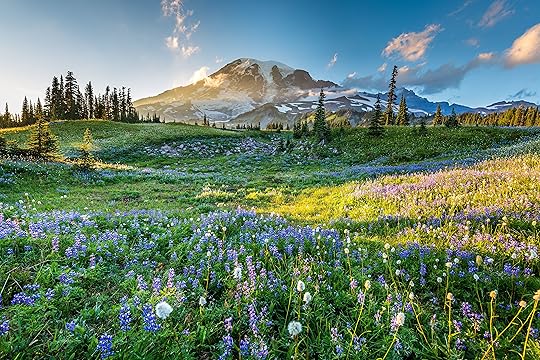
If you’re stuck indoors this winter or bored at work and have already binged through all the classic nature documentaries, we’ve got your outdoor and wildlife fix covered. All across the US, the National Park Service hosts a collection of livestream webcams allowing you to virtually visit your favorite national park in real time. From watching Alaskan brown bears catch salmon to witnessing nesting bald eagles, here are the best national park webcam feeds in the US.
1. Yellowstone National Park

Photo: Razak.R/Shutterstock
Yellowstone National Park contains half of the world’s geysers, approximately 500 or so. Of these geysers, Old Faithful is one of the most famous. The geyser has been a centerpiece of the park since its founding in 1872. Its daily eruptions can be viewed by people anywhere in the world on Yellowstone’s webcams. The eruptions occur on a predictable schedule about every 90 minutes, and the site has included prediction times and charts to help viewers tune in close to the spectacle.
2. Zion National Park
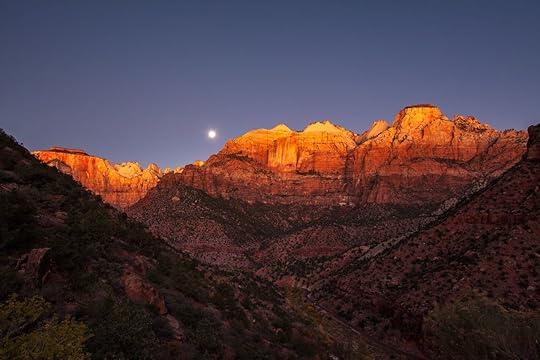
Photo: Philip Bird LRPS CPAGB/Shutterstock
Zion National Park is known for its hiking trails such as Angels Landing, which climbs a steep rock formation overlooking the canyon, and The Subway, which passes through a tubular canyon created over time by water erosion.
Another popular destination in Zion National Park is the Temples and Towers of the Virgin rock formation. These cliffs are a popular stop for visitors and photographers, especially during sunsets and sunrises when the light enhances the peak’s colors.
The park has installed webcams that face these peaks for those who are unable to visit the park in person. A great time to log on to the webcam is in the early morning hours at sunrise, or at the end of the day for sunset.
3. Rocky Mountain National Park

Photo: Alfie Photography/Shutterstock
A vibrant wildlife population lives in Rocky Mountain National Park. One of the more abundant residents is the North American elk, a member of the deer family.
The webcams stationed in the park provide viewing opportunities to see the elk during every season. From late May into early June, tune in to view the calving season. During September and October, you can watch the elk rut, when the males aggressively compete for mates. Although winter is not as dramatic a season to watch these animals, the elk provide a nice desktop backdrop, foraging for food in the lower valleys of the park.
4. Katmai National Park
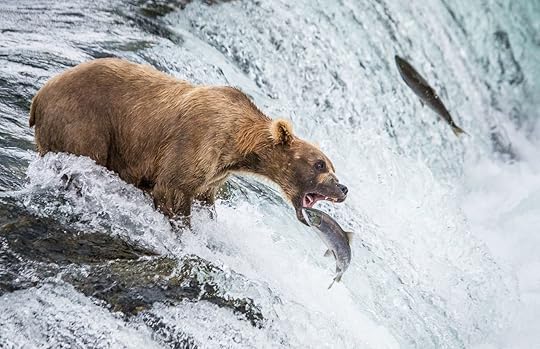
Photo: GUDKOV ANDREY/Shutterstock
Katmai National Park is one of the best places to safely watch brown bears from the raised walkways in the park which keep visitors and animals safely separated.
The Alaskan brown bear is an enormous animal, weighing 800 to 1,200 pounds and standing nine feet tall on its hind legs. Over 2,000 of these animals live in the park, and they congregate near the rivers of coastal Alaska during the summer months.
Katmai National Park has webcams at six of the animal’s favorite hangout spots. Viewers can observe the bears hunting, feeding, and foraging in real time. Cubs are also frequent visitors to these locations, accompanying their mothers on fishing trips. The park also uses the webcams to host fat bear week, an annual contest where viewers vote on which bear is putting on the most pre-hibernation fat.
5. Mount Rainier National Park

Photo: Roman Khomlyak/Shutterstock
The peak of Mount Rainier National Park stands at 14,411 feet above sea level and is the tallest mountain in Washington state.
Webcams at the park are stationed in 11 different locations with views of the Rainier mountain, the Tatoosh range, and believe it or not, the parking lot at the visitor center. Several of the additional webcams, such as the camera at Camp Muir, 10,000 feet up Mount Rainier, are down for the winter season and will reopen in summer. The webcams currently streaming are intended to help visitors gauge the weather, traffic, and parking conditions at the lower elevations in the park. The images are only updated every 15 minutes, so don’t expect to see any realtime animal action on these feeds.
6. Glacier National Park

Photo: Pung/Shutterstock
Glacier National Park, located in Montana, is characterized by rugged peaks, a large and varied wildlife population, and grand glacial valleys.
There are several webcams in the park highlighting the mountainous terrain, including the Many Glacier webcams, which overlook Swiftcurrent Lake and the peaks beyond. This spring, one of the newer cameras in the park was focused on a black bear den in a cottonwood tree, and viewers were able to watch the family. In the interest of attracting more viewers, the park is currently renovating its cameras, replacing older ones with newer, higher quality models.
7. Grand Teton National Park

Photo: Sean Xu/Shutterstock
Grand Teton National Park is located near Jackson Hole, Wyoming, not too far from Yellowstone National Park. The Teton mountains, from which the park takes its name, are the star attractions for visitors as well as webcam viewers.
The peaks are visited by hikers, climbers, and other outdoor thrill seekers, and the webcams in this area are intended to help visitors plan and prepare for their expeditions. One of the webcams, located at the American Alpine Club’s Climber’s Ranch, assists climbers who need to check the weather conditions on the peaks before they start out onto the mountain. As weather conditions change frequently at high elevations, webcam updates support vital decision-making at the beginning of a climbing expedition.
The Jackson Hole ski village also hosts webcams offering views of the ski lifts, ski bases, and mountains. These cameras allow skiers and other snowsport fans check the conditions on the mountain before leaving their cozy ski lodges.
8. Channel Islands National Park

Photo: Bram Reusen/Shutterstock
Channel Islands National Park protects five islands and their surrounding waters off the coast of California. The ecosystem supports fish, kelp forests, seabirds, and several species of marine mammals. In addition to these animals, the park is home to a healthy population of bald eagles that hunt and breed there.
There are two webcams in the park that provide an intimate look at the nests of breeding eagle pairs during the season. Every spring the mated eagles lay one or two eggs in a nest built on a raised platform. Unlike other birds, they will return to the same nest and add to it every year, increasing its size and strength over their reproductive lifetime. After hatching, the baby eagles will remain in the nest for 10 to 12 weeks while being cared for by both parents. Webcam viewers are able to watch their development from adolescence up to when they leave their nest.
Below the surface, Channel Islands National Park also offers a glimpse into the ocean world surrounding the islands using an underwater webcam. This webcam is not stationary and shows a dynamic, changing view of the kelp forest and its inhabitants. Common sightings are of the various fish, sharks, and marine mammals that live here. Sea lions can be especially curious, inspecting the cameras up close. This camera also has sound features, so you can turn the volume up to enjoy the peaceful sounds of the sea. 

More like this: 15 US state parks that are just as epic as national
The post The 8 best national park webcams (and when to check in) appeared first on Matador Network.

Beautiful mosaics around the world

Often found in churches and mosques, mosaics seem like a simple art in practice — after all, they’re produced by assembling small bits of tile, glass, ceramic, or stone into patterns and pictures — yet on a grand scale, the result is a stunning visual display. From Uzbekistan to Iran, check out some of the most beautiful mosaic works around the world to spice up your bucket list with a bit of artistic intrigue.
1. Hassan II Mosque — Casablanca, Morocco

Photo: Vixit/Shutterstock
The Hassan II Mosque is the largest in Morocco and also features the world’s largest minaret, which towers nearly 700 feet. Construction took seven years and 10,000 craftsmen, and the top is adorned with hundreds of shades of blue and green tiles arranged in traditional Islamic patterns.
2. Basilica of San Vitale — Ravenna, Italy

Photo: Gimas/Shutterstock
Italy is the land of jaw-dropping mosaics. In addition to the spectacle of St. Peter’s Basilica in Vatican City, the interior of the Basilica of San Vitale in Ravenna is adorned with a series of mosaics depicting various scenes from the Old Testament, such as the story of Moses and the Burning Bush and the lives of Abel and Cain. Rich in symbolism, the mosaics are some of the most elaborate in the world and are comprised of rich colors and abundant gold, making for a stunning display.
3. Kalta Minor minaret — Khiva, Uzbekistan

Photo: Dudarev Mikhail/Shutterstock
The barrel-shaped Kalta Minor minaret towers high over the neighboring Sayid Alauddin Mausoleum. Its entire surface is adorned with glazed tile and majolica, a type of pottery, in hues of bright turquoise and deep azure. The minaret was originally planned to be much taller, but the ruler in charge of the process was killed and construction ceased upon his death, so the tower remains “unfinished” — albeit eye-catching — to this day.
4. Jāmeh Mosque — Isfahan, Iran

Photo: Razak.R/Shutterstock
An architectural marvel, Isfahan’s Jāmeh Mosque dates all the way back to the 700s but has been continually expanded and modified through the centuries. Decorative tile and brickwork coat the four gates, and one of the most distinctive elements of the mosque is its archway of honeycombed muqarnas, which add depth and texture to the vaulted ceilings.
5. Parc Güell — Barcelona, Spain
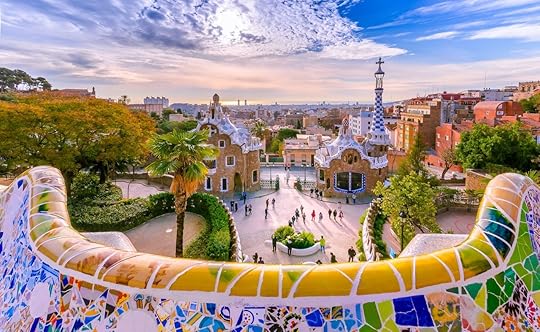
Photo: Georgios Tsichlis/Shutterstock
Arguably architect Antoni Gaudí’s greatest masterpiece — though it faces stiff competition from the still-under-construction Sagrada Familia — Parc Güell is a winding public park in Barcelona. Dating back to the early 1900s, Parc Güell’s highlights include gardens, viaducts, stone colonnades, and structures that resemble larger-than-life gingerbread houses. Thousands of mosaics color the entire park, coating everything from roofs to ceilings to elongated benches to animal shapes like lizards and dragon heads.
6. Golestan Palace – Tehran, Iran

Photo: eFesenko/Shutterstock
Tehran’s lavish Golestan Palace is actually a sprawling complex consisting of 17 buildings from palaces to museums and halls. Multi-colored tiles adorn the walls and ceilings of the Pond House, which was used as a summer chamber during the Qajar dynasty and pumped water through small ponds in order to cool the rooms and irrigate the gardens.
7. La Maison Picassiette — Chartres, France

Photo: Amy Corti/Shutterstock
France’s La Maison Picassiette is an entire house and yard of mosaics, collected and assembled by a graveyard sweeper between the years 1938 and 1964. The mosaics that cover every visible inch of the house — inside and out, from floor to furniture — are made from crude elements such as broken dishes and other assorted bits that the sweeper found around the city. The eccentric design is so elaborate that Picasso himself paid the site a visit.
8. Cathedral Basilica of St. Louis — St. Louis, Missouri

Photo: Nagel Photography/Shutterstock
Large domes, vaulted roofs, and massive archways draw the eyes heavenward at the Cathedral Basilica of St. Louis, where thousands of colorful tiles depict scenes from the Bible. According to the cathedral, the mosaics “were designed to teach all of us that God reaches into our earthly lives.”
9. Shah Cheragh — Shiraz, Iran

Photo: Martchan/Shutterstock
Nicknamed the “mirror mosque,” Shah Cheragh is actually a somber funeral monument and serves as a pilgrimage destination for Shia Muslims. Thousands of fractured mirrors and shards of glass cover the interior of the mosque from floor to ceiling, creating a brilliantly lit spectacle. 

More like this: The 7 most jaw-dropping ceilings around the world
The post The 9 most beautiful mosaic works around the world appeared first on Matador Network.

At-gate greetings at Seattle airport

Since 9/11, the old movie cliche of running through the airport to meet someone at the gate and dramatically proclaiming your love for them, has been off the table. For the past 17 years, we have not been able to walk through security with our shoes on, stray mints in our pockets have triggered TSA alarms, and at-gate greetings have been banned. But if this new rule at the Seattle-Tacoma International Airport is any indication of things to come, we might be going back to the good old days. Sea-Tac’s new “Visitor Pass Program” — the first of its kind in the US — will allow people without tickets to access domestic travel gates following a TSA screening.
In a phone call, Lance Lyttle, managing director at Sea-Tac, told The Seattle Times, “For me it is nostalgic. As a child I used to go to the airport and watch loved ones board the plane and depart. The fact that you can say goodbye to your loved one or child or meet them at the gate or surprise them is very exciting.”
The program’s trial, which will run from November 9 to December 14, will only accept 50 visitors per day, and they must sign up online before 1:30 PM the day prior to their visit. If they are approved, they can pick up their passes at the airport. Right now, the program is only available on from Tuesday to Sunday between 8 AM and 10 PM to limit congestion at security checkpoints. 
H/T: Insider

More like this: All of the food you can’t take through airport security
The post Seattle airport is letting you meet your loved ones at the gate again appeared first on Matador Network.

University allows pets in dorms

When you leave for college, you want your new roommate to be someone loyal who understands you and is always happy to see you when you come home from class. As far as humans are concerned, that kind of roomie is hard to come by. That’s why Lock Haven University in Pennsylvania is introducing pet-friendly dorms. Starting in spring 2019, North Residence Hall will allow school-approved pets to come live with students.
Emmy Borst, resident director for Lock Haven University, said in a statement, “Studies show that students who feel at home on campus are the students that thrive both socially and academically.” The university believes that allowing students to bring their pet to school is an optimal way of making them feel comfortable. Approved pets include dogs, cats, rabbits, hamsters, gerbils, guinea pigs, and fish. Pets must be at least six months old, weigh under 40 lbs, kept on a leash when outside the dorm, and have been owned by the student for a minimum of three months. To be granted permission, students must submit an application with a photo of their pet, current vaccination records, and spay and neuter records.
In addition to making students feel more at home in a new college environment, pets are also expected to facilitate socialization between students and encourage outdoor activity. “Introducing a pet-friendly residence hall is about increasing opportunities for our students,” said LHU President Robert Pignatello. “The Haven is a great place to live and learn — and allowing students to bring a beloved pet to campus will only enhance their residential experience.”
While Lock Haven is the first university within the Pennsylvania state college system to allow pets, it’s not the first nationwide. There are actually 40 pet-friendly universities across the country, though all universities are required to allow service and support animals in dorms. 
H/T: Bustle

More like this: The 11 most beautiful college campuses in the US
The post This university will let students bring their pets to college appeared first on Matador Network.

Nevada as you've never seen it
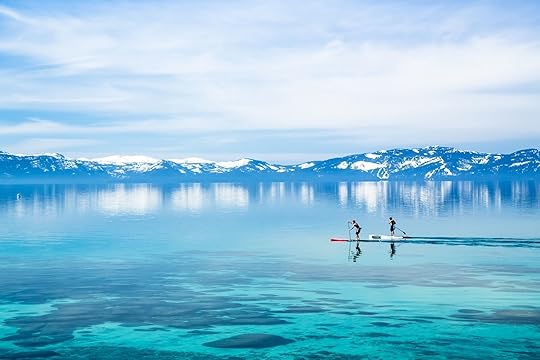
Nevada as you’ve never seen it
Lake Tahoe. Photo: Shutterstock/Topseller
Nevada covers a hefty 110,000 square miles — you could fit three Indianas in there, or 11 Marylands. And while it’s simpler on the imagination to picture this vast landscape as all ghost towns and desert, you’d be missing a whole hell of a lot: the alpine lakes, the snow-capped mountain ranges, the singing sand dunes, the art enclaves, the surreal rock formations, the lush river valleys.
And don’t forget — you’ll rail against the gas gauge before you’ll fight the crowds. These 110,000 square miles have more wild horses and bighorn sheep than they have humans, and the people you do run into almost always have a story to tell.
Okay, you’ve been to Las Vegas, but you don’t know Nevada. And these travel ideas only scratch the surface of a state you’ve never truly seen.

This post is proudly produced in partnership with TravelNevada.
Black Rock Desert
Fly Geyser
Burning Man Festival
Desert Vegetation
Burners at sunset
Not black, not rock, not exactly desert. These 300,000 acres of northwestern Nevada were once underwater — now they’re made up of dry alkali flats, narrow canyons, and straight-up mountains (yep, the name is a bit of a misnomer). There’s hundreds of miles of historic trails here, though most visitors come for something a bit more modern: Burning Man.
The experience: Grab all the water you can carry and backpack into the High Rock Canyon Wilderness. There will be wild horse trails you can follow, old homesteads to wander around, and bighorn sheep to view (from a safe distance, of course).
The nearby eats: The only restaurant in nearby Gerlach is Bruno’s Country Club, but it’s the only one you’ll need.
The unexpected vantage point: If you can, summit Donnelly Peak (8,533 feet). It’s not the highest in the area, but it’s the most centrally located, giving you not-soon-forgotten 360-degree views.
Photos provided by: Shutterstock/Ryland West, Shutterstock/Neil Lockhart, and Shutterstock/Sunshine Seeds
Great Basin National Park
Wheeler Peak
Fall colors at Great Basin
Dark skies
Bristlecone pine
Great Basin is all about extremes, including extreme diversity. This national park is home to 13,000-foot peaks, ancient trees, limestone caves, glaciers, and some of the best stargazing anywhere in the world (with a fraction of the crowds at other Western national parks).
The experience: Great Basin National Park is an International Dark Sky Park. Come after sunset on a moonless night and check out the Andromeda Galaxy — with your naked eye.
The nearby eats: At Kerouac’s in Baker, their pizzas are made with a homemade dough that will spoil your taste buds for years.
The unexpected vantage point: Take the Bristlecone Trail to see the namesake pine trees…which might not sound that exciting, until you learn that these trees are the oldest living things on Earth (we’re talking upwards of 5,000 years!). Great Basin is also where you can snag a peek of Nevada’s only glacier, on Wheeler Peak.
Photos provided by: Sydney Martinez/TravelNevada
Jarbidge
Jarbidge Wilderness
Town of Jarbidge
Fly-fishing in Jarbidge
That’s the Shoshone word for “devil.” Jury’s still out on whether or not these hills are haunted by a man-eating giant, but between the 100,000+ acres of Jarbidge Wilderness and the old-school Jarbidge mining town, anything’s possible.
The experience: Snowslide Gulch, Slide Creek, and Three Day Creek all have trailheads that take you deep into Nevada’s first protected wilderness. Whichever route you choose, you won’t have to battle crowds.
The nearby eats: Jarbidge is one of the most isolated towns in the country (check out that Google map!), and The Outdoor Inn is where you’ll find most of Jarbidge’s 100-odd residents.
The unexpected vantage point: Get into the wilderness in autumn and find an aspen grove. Once you’re done admiring the golden foliage, focus your eyes lower down the trunks and hunt for arboglyphs, old tree carvings left by Basque sheepherders.
Photos provided by: Sydney Martinez/TravelNevada
Lake Tahoe
Mountain biking with a view
Winter in Chickadee Ridge
Lake Tahoe's clear waters
Paddleboarders crossing the lake
Lake Tahoe at sunset
Mirror-like water, mountains on all sides…you know a photo of Lake Tahoe when you see it. It’s the largest alpine lake in North America — so large that when you see it in its full expansive glory, you can just about detect the curvature of the Earth.
The experience: Ride up the Heavenly Gondola to fathom the immensity you’re dealing with. Then get down on the ground (mountain bike!) or on the water, preferably by kayak or stand-up paddleboard.
The nearby eats: You’re in one of the most beautiful places in the world. Why hold back? Head to the Lone Eagle Grille in Incline Village and send us a thank you postcard later.
The unexpected vantage point: Sand Harbor. Jump off the rocks, set up your tripod, whatever — just bask in the sight of these weirdly blue-green waters that magically prop up those mountains.
Photos provided by: Rick Gunn, Sydney Martinez/TravelNevada, Shutterstock / Topseller, and Shutterstock/John Santoro
Ruby Mountains
Sunny day at Lamoille Canyon
Fresh powder
Lamoille Canyon Scenic Byway
Yurt at Ruby Mountain
Northern Nevada is marked by ridge after ridge of scenic mountains, but the Rubies are in a class of their own. Visitors flock here for the scenery, hiking, horseback riding, and backpacking. And that’s just in the summer. Once the snow starts falling, it’s all about the epic backcountry skiing, best accessed via helicopter.
The experience: Roll the windows down on the 12-mile Lamoille Canyon Road, a scenic byway, and you’ll see what this glacier-carved range is all about. In winter, book a backcountry excursion with a local operator and get acquainted with a true powder playground.
The nearby eats: The Star Hotel. Its Basque Dining Room was once a watering hole for local sheepherders, but these days its garlic soup does the talking.
The unexpected vantage point: For the hardcore (and appropriately experienced), it has to be the top of Terminal Cancer, a couloir in the Rubies that looks more like a bobsled chute.
Photos provided by: Chris Moran/TravelNevada, David Bunker/TravelNevada, and TravelNevada
Carson Valley
Biking Carson Valley
View from above
Jobs Peak
Genoa Main Street
Just south of the capital (that’s Carson City, not Las Vegas) is the Carson Valley, the wilder side of the legislative seat. The Carson River is your compass here, while the Sierra Nevada will never not be towering over you.
The experience: Hit the Sierra Canyon Trail on your mountain bike, and you’ll descend nearly 4,000 from high up in the Sierra down toward the valley floor. There’s no better way to take in the local topography.
The nearby eats: The JT Basque Bar & Dining Room might be the only place where you can get an “old-timey,” “saloon,” and “ethnic” experience all from the same seat.
The unexpected vantage point: The Tahoe Rim Trail is bonafide camera candy. (You can access it off US-50 west of Carson City; grab one of the local trail association’s maps to get started.)
Photos provided by: Rick Gunn, Sydney Martinez/TravelNevada, and Shutterstock/Jeffrey T. Kreulen
Virginia City
Virginia City's Main Street
Living Legends
Silver Dollar Saloon
Upside Down Church
The Washoe Club
Welcome to the original boom town. For silver, at least. The Comstock Lode was discovered here in 1859 and Virginia City materialized around it. Over the next 40 years, the local silver mines financed the rapid development of the West Coast, and today the town is one of the most storied in America. Its motto? “Step Back in Time.”
The experience: Wander C Street, the boardwalk, and step into at least a couple of the old saloons. At least.
The nearby eats: In Virginia City, you’ve got loads of choices. Start out at Cafe del Rio, the Cider Factory, or the Canvas Cafe — the first two are in historic buildings, and the third showcases work from local artisans.
The unexpected vantage point: Down in the mine. It’s what the entire town is built from, after all. With the Comstock Adventure Pass, you can go on a mine tour and get access to all kinds of other local experiences.
Photos provided by: Virginia City Tourism Commission and Sydney Martinez/TravelNevada
Sand Mountain Recreation Area
ATVs at Sand Mountain
Sand Mountain Recreation Area
Off-roading
Sand Mountain landscape
When Lake Lahontan dried up 9,000 years ago, this waterfront property turned into an off-roading paradise. Sand Mountain is literally a mountain of sand — and it’s open to your feet, your dirt bike, and your (off-highway) vehicle.
The experience: This six-story sand dune sings. When the wind is blowing just right, be silent. The next few minutes could put on quite the show.
The nearby eats: JD Slinger’s in Fallon has mastered their famous Burnt Bacon Burger. For more vegetarian-friendly options, check out The Slanted Porch.
The unexpected vantage point: The top of the mountain provides one hell of a vista, but snapping a photo of the dune from the Loneliest Road in America (US-50, which passes to the south) will make your Instagram proud, too.
Photos provided by: Sydney Martinez/TravelNevada
Weird Nevada
Paradise Ranch Castle
International Car Forest of the Last Church
Laughlin Labyrinths
Neon Museum
Tonopah Cemetery
The phrase is almost redundant — nearly everywhere in Nevada is doing its own thing. Where else would you find a “forest” of cars? A clown motel? A mountain made of…stuff? Aliens, ghost towns, and just plain ol’ Las Vegas?
The experience: Haunted Wax. Thunder Mountain. Mannequin crews — we’re not even going to try picking just one. Instead, check out this list and narrow it down yourself.
The nearby eats: Food gets weirder in Nevada. Grasshoppers, sea cucumber, frogs legs, and all-you-can-eat everything (its own kind of weird) exist around every corner. Pick your poison.
The unexpected vantage point: You can’t go wrong trying to replicate any of the images above. Or just set your GPS to the Goldwell Open Air Museum and behold.
Photos provided by: Jessica Peterson and Sydney Martinez/TravelNevada
Midtown Reno's Murals
Keeping Art Alive
Good Luck
Midtown Murals
Reno Playa Art Park
Melting Pot
There are over 80 murals in Reno’s Midtown, and that’s just as of the time of writing. The biggest little city has seen an artistic renaissance, and nowhere is that clearer than in its alleyways. Grab the associated app, and get to scouting.
The experience: Outside of Midtown, you’ll want to check out the Riverwalk District. Set aside a couple hours to wander — this neighborhood is home to a bunch of awesome cafes and shops.
The nearby eats: Peg’s Glorified Ham n Eggs. That’s a restaurant, not a dish, and they’re the best breakfast in town, decades running. Expect a California-Mexican-Hawaiian-comfort fusion.
The unexpected vantage point: Find as many murals as you can and snap them all. Which one’s your fave?
Photos provided by: Timmy Dwyer and Sydney Martinez/TravelNevada
The Loneliest Road in America
The Loneliest Road
Highway 50
Loneliest road sunset
Highway 50 bisects the country, running from Sacramento to Ocean City, Maryland, but it’s only in Nevada that you’ll spend hours driving its length without spotting a speck of civilization. LIFE magazine came up with the name, but everyone else knows that even if the open road is lonely, it’s still king.
The experience: Start at Fallon and head east. For the next 400 miles or so, you’ll pass through just a handful of small towns, riding along the old Pony Express route. In other words? Gas up.
The nearby eats: Nothin’ like a late-night taco from Margarita’s in Ely (one of the aforementioned small towns).
The unexpected vantage point: The mountains around Austin will add another dimension to your otherwise beautifully stark panoramas.
Photos provided by: Sydney Martinez/TravelNevada and TravelNevada

This post is proudly produced in partnership with TravelNevada.
The post Nevada as you’ve never seen it appeared first on Matador Network.

Matador Network's Blog
- Matador Network's profile
- 6 followers



